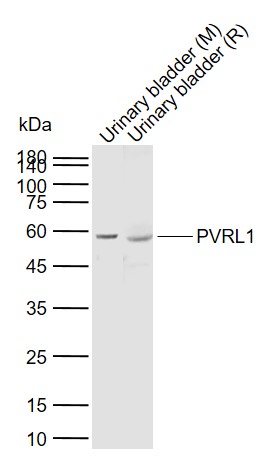![FACS analysis of human peripheral blood using GTX00514 Nectin 1 antibody [R1.302]. FACS analysis of human peripheral blood using GTX00514 Nectin 1 antibody [R1.302].](https://www.genetex.com/upload/website/prouct_img/normal/GTX00514/GTX00514_20191028_FACS_1_w_23053121_470.webp)
FACS analysis of human peripheral blood using GTX00514 Nectin 1 antibody [R1.302].
Nectin 1 antibody [R1.302]
GTX00514
ApplicationsFlow Cytometry, ImmunoFluorescence, ImmunoPrecipitation, Western Blot, ImmunoCytoChemistry, ImmunoHistoChemistry
Product group Antibodies
TargetNECTIN1
Overview
- SupplierGeneTex
- Product NameNectin 1 antibody [R1.302]
- Delivery Days Customer9
- ApplicationsFlow Cytometry, ImmunoFluorescence, ImmunoPrecipitation, Western Blot, ImmunoCytoChemistry, ImmunoHistoChemistry
- CertificationResearch Use Only
- ClonalityMonoclonal
- Clone IDR1.302
- Concentration1 mg/ml
- ConjugateUnconjugated
- Gene ID5818
- Target nameNECTIN1
- Target descriptionnectin cell adhesion molecule 1
- Target synonymsCD111, CLPED1, ED4, HIgR, HV1S, HVEC, OFC7, PRR, PRR1, PVRL1, PVRR, PVRR1, SK-12, nectin-1, nectin-1, ectodermal dysplasia 4 (Margarita Island type), herpes simplex virus type 1 sensitivity, herpes virus entry mediator C, herpesvirus Ig-like receptor, nectin 1, poliovirus receptor-like 1, poliovirus receptor-related 1 (herpesvirus entry mediator C), poliovirus receptor-related protein 1
- HostMouse
- IsotypeIgG1
- Protein IDQ15223
- Protein NameNectin-1
- Scientific DescriptionThis gene encodes an adhesion protein that plays a role in the organization of adherens junctions and tight junctions in epithelial and endothelial cells. The protein is a calcium(2+)-independent cell-cell adhesion molecule that belongs to the immunoglobulin superfamily and has 3 extracellular immunoglobulin-like loops, a single transmembrane domain (in some isoforms), and a cytoplasmic region. This protein acts as a receptor for glycoprotein D (gD) of herpes simplex viruses 1 and 2 (HSV-1, HSV-2), and pseudorabies virus (PRV) and mediates viral entry into epithelial and neuronal cells. Mutations in this gene cause cleft lip and palate/ectodermal dysplasia 1 syndrome (CLPED1) as well as non-syndromic cleft lip with or without cleft palate (CL/P). Alternative splicing results in multiple transcript variants encoding proteins with distinct C-termini. [provided by RefSeq, Oct 2009]
- Storage Instruction2°C to 8°C
- UNSPSC12352203





